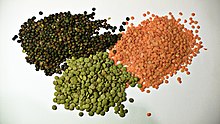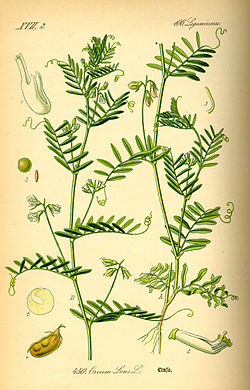| Lentil | |
|---|---|
 | |
| Lentils | |
| Scientific classification | |
| Kingdom: | Plantae |
| (unranked): | Angiosperms |
| (unranked): | Eudicots |
| (unranked): | Rosids |
| Order: | Fabales |
| Family: | Fabaceae |
| Subfamily: | Faboideae |
| Tribe: | Vicieae |
| Genus: | Lens |
| Species: | L. culinaris |
| Binomial name | |
| Lens culinaris Medikus | |
Contents
|
Background
The plant likely originated in the Near East,[1] and has been part of the human diet since the aceramic (non-pottery producing) Neolithic times, being one of the first crops domesticated in the Near East. With approximately 26% of their calories from protein, lentils and generally any pulses or legumes have the third-highest level of protein, by weight, of any plant-based food after soybeans and hemp[2] and is an important part of the diet in many parts of the world, especially in the Middle East and the Indian subcontinent which has large vegetarian populations. Lentil is also commonly used in Ethiopia as a stew like dish called Kik, or Kik Wot, which is one of the dishes people eat with Ethiopia's national food, the Injera flat bread. The yellow lentils are used to make a non spicy stew like dish, which is one of the first solid foods Ethiopian women feed to their babies.A variety of pulses or lentils exists with colors that range from yellow to red-orange to green, brown and black. Red, white and yellow lentils in some cases are peeled, i.e., are those that have their skins removed before being sold. There are large and small varieties of many lentils (e.g., Masoor Lentils, shown in photos here). Lentils are sold in many forms, with or without the skins, whole or split.
Culturally, other pulses are sometimes called lentils but are actually beans or peas, e.g. "black lentils" (urad beans).
Types
- Brown/Spanish Pardina
- French Green/Puy lentils (Dark speckled blue-green)
- Green
- Black/Beluga
- Yellow/Tan Lentils (Red inside)
- Red Chief (Decorticated yellow lentils)
- Eston Green (Small green)
- Richlea (Medium green)
- Laird (Large green)
- Petite Golden (Decorticated lentils)
- Masoor (Brown-skinned lentils which are red inside)
- Petite Crimson/Red (Decorticated masoor lentils)
- Macachiados (Big Mexican yellow lentils)
Preparation
Lentils should not be eaten raw, due to the presence of anti-nutrients such as phytic acid and tannins; some types of lentils require soaking overnight before cooking as well.[3]The seeds require a cooking time of 10–30 minutes, depending on the variety (shorter for small varieties with the husk removed, such as the common red lentil) and have a distinctive earthy flavor. Lentils are used throughout South Asia, the Mediterranean regions and the Middle East. They are frequently combined with rice, which has a similar cooking time. A lentil and rice dish is referred to in the Middle East as mujaddara or mejadra. Rice and lentils are also cooked together in khichdi, a popular Indian dish; a similar dish, kushari, is made in Egypt and considered one of two national dishes. Lentils are used to prepare an inexpensive and nutritious soup all over Europe and North and South America, sometimes combined with some form of chicken or pork.
Dried lentils can also be sprouted by leaving in water for several days. This changes the nutrition.
Nutritional value and health benefits
| Nutritional value per 100 g (3.5 oz) | |
|---|---|
| Energy | 1,477 kJ (353 kcal) |
| Carbohydrates | 60 g |
| Sugars | 2 g |
| Dietary fiber | 31 g |
| Fat | 1 g |
| Protein | 26 g |
| Thiamine (Vit. B1) | 0.87 mg (67%) |
| Folate (Vit. B9) | 479 μg (120%) |
| Iron | 7.5 mg (60%) |
| Percentages are relative to US recommendations for adults. Source: USDA Nutrient database | |
Apart from a high level of proteins, lentils also contain dietary fiber, folate, vitamin B1, and minerals. Red (or pink) lentils contain a lower concentration of fiber than green lentils (11% rather than 31%).[7] Health magazine has selected lentils as one of the five healthiest foods.[8] Lentils are often mixed with grains, such as rice, which results in a complete protein dish.
Lentils also have "anti-nutritional factors" such as trypsin inhibitors and relatively high phytate content. Trypsin is an enzyme involved in digestion and phytates reduce the bioavailability of dietary minerals.[9] The phytates can be reduced by soaking the lentils in warm water overnight.
Iron content
Lentils are a good vegetable source of iron. This makes them useful for preventing iron deficiency.[citation needed] Iron is particularly important for adolescents and pregnant women, whose requirements for it are increased.[10]Production
Lentils are relatively tolerant to drought and are grown throughout the world. About a third of the worldwide production of lentils is from India, most of which is consumed in the domestic market. Canada is the largest export producer of lentils in the world and Saskatchewan is the most important producing region in Canada. The Palouse Region of Eastern Washington and the Idaho Panhandle, with its commercial center at Pullman, WA, constitutes the most important producing region in the United States.[11]FAO reports that world production of lentils for calendar year 2008 is 3.874 million metric tonnes, primarily coming from Canada, India, Nepal and United States. National Agricultural Statistics Service (NASS) reports United States 2007 production at 154.5 thousand metric tonnes, primarily coming from North Dakota, Montana, Washington, and Idaho. Statistics Canada estimates that Canadian lentil production for the 2009/10 year is a record 1.5 million metric tonnes.[12]
| Top ten lentil producers – 2008 | ||||
|---|---|---|---|---|
| Country | Production (tonnes) | Footnote | ||
| 1,043,200 | ||||
| 810,000 | ||||
| 161,147 | ||||
| 108,545 | ||||
| World | 3,873,801 | A | ||
| No symbol = official figure, P = official figure, F = FAO estimate, * = Unofficial/Semi-official/mirror data, C = Calculated figure A = Aggregate (may include official, semi-official or estimates); Source: Food And Agricultural Organization of United Nations: Economic And Social Department: The Statistical Division | ||||
Diseases
Main article: List of lentil diseases
In culture
Lentils were the main ingredient in food of ancient Iranians. Iranians consumed lentils daily in form of stew that was poured over rice. Lentils are mentioned many times in the Old Testament, the first time recounting the incident in which Jacob purchases the birthright from Esau with stewed lentils (a "mess of pottage")[13] In Jewish mourning tradition, they are considered as food for mourners, together with boiled eggs. The reason is that their round shape symbolizes the life cycle from birth to death.In Shia narrations, Lentils are attributed to be blessed by seventy Prophets including Jesus and Mohammed[14].
In Italy eating lentils on New Year's Eve traditionally symbolizes the wish to earn more money next year, most likely because of their round coin-like shape.
In the Grimm's Fairy Tales "Cinderella" one of the tasks her step-mother assigns to Cinderella is fishing lentils out of ash. If she is successful in this then she may go to the ball.





No comments:
Post a Comment